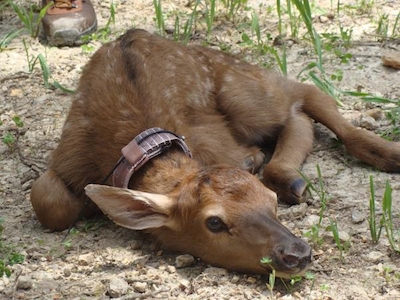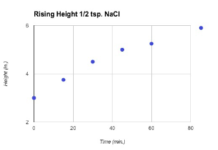Summer brings the incredible sounds of Missouri wildlife: the gobbling of turkeys, the snort and blow of a buck deer, the song of the cicadas . . . and the bugling of an elk? Due to the latest restoration project of the Missouri Department of Conservation (MDC), the bugling of elk may become a common sound in southeastern Missouri.

On May 24, 2011, 34 adult elk were released into the Peck Ranch Conservation Area, located in Shannon, Reynolds and Carter Counties, according to the MDC website. But are all Missourians happy to see these once native animals returned to Missouri?
These 34 animals have created quite a stir in the state legislature. Spurred by concern for potential elk, legislators presented House Bill 115 and Senate Bill 299[PDF] requiring the MDC to own, title and be financially responsible for all damages caused by elk, according to the Missouri House website. These bills attracted a lot of attention, but failed to come to a vote in either chamber before the end of the legislative session.
The major support of these bills came from agriculture groups, including the Missouri Farm Bureau (MFB) and the Missouri Cattlemen’s Association. An October 8, 2010 letter from, then-president, Charlie Kruse, of the MFB, expressed concerns about the elk restoration, including the potential for the spread of potentially fatal diseases, such as brucellosis—an infectious disease found in cattle, swine, and deer populations that can also infect humans; tuberculosis; and chronic wasting disease (CWD)—a disease similar to “Mad Cow Disease”, or more formally bovine spongiform encephalopathy, that is found in the deer family.
Kruse also warned about the potential of automobile crashes with elk and a resultant increase in insurances rates, and damage to private property, crops and forage fields. For example, the MFB points out that the cattle industry is a $1.6 billion dollar business in Missouri and may be threatened with this new disease potential.
This letter also quoted the Reynolds County Commissioners and the Missouri Department of Transportation with their concerns about the potential safety risk to drivers, especially if the elk wandered onto heavily traveled Highway 60.
According to the Rocky Mountain Elk Foundation (RMEF), an organization promoting elk, bull elk have been documented to travel over 50 miles in a day. Some local landowners in the release area have questioned whether the elk will stay within the 364 square mile restoration area and off the local highways.
With all of these concerns, why were the elk reintroduced? According to the MDC’s website, one of the strategic goals of the agency is “to preserve and restore the state’s biodiversity.” The restoration of the elk represents a return of a species that was extirpated from Missouri about 150 years ago. The agency says it has been working to build habitat and learn about elk over the past 30 years.
Lonnie Hansen, MDC Resource Scientist, believes restoration a worthy goal. In a video response on the MDC website, he states, “[health] protocols [for the Missouri elk] are more stringent than any existing disease protocols for livestock or privately imported elk and deer.”
The elk, caught in Kentucky, were tested for CWD, brucellosis, bovine tuberculosis, blue tongue, Johne’s disease, and many other diseases and parasites, according to the MDC Elk Restoration Plan. This wide array of tests was necessary because many of these diseases, like CWD, can be transmitted from elk to the wild and captive deer populations, according to the Chronic Wasting Disease Alliance, but many also fear the possibility of transmission to livestock, especially cattle.
According to the MDC, over 26,000 deer were tested in October, 2010, with no reports of CWD in wild herds in Missouri. The only reported case of CWD in Missouri was at a deer farm in northeastern Missouri in February, 2010, but wild deer in the area tested negative for CWD. Though there has never been a documented case of CWD transmission to cattle, many agriculture opponents to the elk restoration fear it could, just as brucellosis, be transmitted.
Hansen also dismisses the concerns of elk/vehicle accidents. He says data collected in Arkansas reported only one to two accidents a year in the restoration area. The Peck Ranch CA has a lower road density, 1.2 miles per road per square mile, than the Arkansas elk restoration area with 2.1 miles per square mile road density, according to the MDC Elk Restoration Plan.
RMEF explains that during the rut, bull elk will guard his cows, called a harem. On the other hand, male white tail deer pursue females during the rut, causing a higher volume of deer/vehicle crashes. In 2008, this accounted for 3603 crashes, according to the Missouri Highway Patrol. However, opponents to the elk restoration warn that hitting a 700 pound bull elk would be much different than hitting a 150 pound buck deer.
Hansen also says that the implementation is a “soft release”, which is releasing the elk first into a large holding area before moving into the entire restoration area. This technique keeps the elk from bolting from the release area.
According to the RMEF website, elk do migrate in the mountains throughout the year, but migration is not expected at the Missouri site because elk-friendly food, grasses, forbs, acorns, tree bark, and shelter should be available year round. The MDC also plans to control the size of the elk herd through hunting, a potential source of income to the state and region.
Hansen concedes that the elk may not stay inside the designated area, but that this is the best location for the restoration, due to the area’s sparse population and large area of available elk habitat. Others do believe there is still a great risk. “The 34 elk have only been released in the last few weeks-although we can have problems at any time, the risk of damage will increase as the elk herd grows in size,” says Blake Hurst, MFB President.
The MFB also questions the public support of the project. But MDC claims they have the public support, as well as, the local residents. MDC conducted local town-hall meetings in 2010, with more than 300 in attendance, as well as, “2,309 comments by phone, mail, and email” in support of elk restoration, according to the MDC .
But was this a great enough sampling and are farmers in the area still at risk from elk damage? MFB President, Blake Hurst This question will be answered only in time as the elk explore their new territory and Missouri’s citizens decide if the elk are worth the risk.

This work is licensed under a Creative Commons Attribution-NonCommercial-NoDerivs 3.0 Unported License













